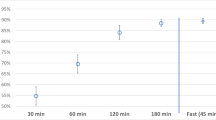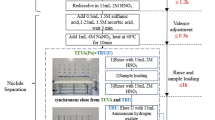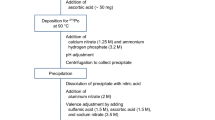Abstract
A rapid bioassay for 90Sr was developed involving preconcentration of 90Sr/90Y from human urine samples with a cation exchange polymer (poly–acrylamido–methyl–propanesulfonic acid) coated onto magnetic nanoparticles, followed by selective elution of 90Sr (over 90Y) with phosphate for determination by liquid scintillation analysis. The minimum detectable activity for this method (4.9 ± 0.5 Bq/L) is lower than the required sensitivity of 19 Bq/L for 90Sr in human urine samples, as defined in the requirements for radiation emergency bioassay techniques for the public and first responders based on the dose threshold for possible medical attention recommended by the International Commission on Radiological Protection. The relative bias was 9.2%, the relative precision was 3.2%, and the linear dynamic range covered 12–600 Bq/L. This simple and rapid bioassay method is found to be in compliance with the HPS ANSI N13.30 performance criteria for radiobioassay.
Similar content being viewed by others
Explore related subjects
Discover the latest articles, news and stories from top researchers in related subjects.Avoid common mistakes on your manuscript.
Introduction
90Sr is a fission product of 235U or 239Pu. As a beta emitter, it can possibly be used as the active component of a radiological dispersal device (RDD). Once dispersed into the air, it can enter the human body via inhalation or ingestion. The body will excrete some of the 90Sr, with the rest deposited in human bones due to its chemical similarity to Ca. Once deposited in the bone, its ionizing radiation causes leukemia and osteosarcoma [1].
Development of a simple and rapid bioassay method for 90Sr must be in compliance with the HPS ANSI N13.30 performance criteria for radiobioassay [2]. One of the main challenges with measuring 90Sr is its daughter ion, 90Y, which is also a beta emitter that interferes with the determination of 90Sr using a liquid scintillation counter (LSC). A quantitative separation of 90Y from 90Sr would hence be required [3]. One approach used co-precipitation and wet ashing. These methods had excellent detection limits, but involved large sample volumes and required lengthy sample preparation times (overnight in one case) with multiple steps [4, 5]. Extraction chromatography was used to analyze samples automatically with fast turnaround time (30 min per sample) and a low detection limit of 4.4 Bq/L [6]. Cation exchange columns using phosphate as a mask allowed a relatively quick turnaround time (<1 h) but has high detection limit of 40–120 Bq/L [7, 8]. Special Eichrom resins were commonly used to attain 16 mBq/L, but required 3 h and 100 mL samples [9]. A rapid bioassay method was developed for the selective extraction of 90Sr by dicyclohexano-18-crown-6 (DCH18C6), but the removal of 90Y by precipitation with TiO2 was not automated [10]. A new method, reported recently by Hrdina et al. [3] involved poly2-acrylamido-2-methyl-1-propanesulfonic acid (PAMPS)-coated magnetic particles modified with di-tert-butyl-cyclohexano-18-crown-6 (DtBuCH18C6). The particles were shown to bind Sr2+ in a urine sample under basic conditions, but they also took up yttrium unless a co-precipitation and centrifugation is added. However, these particles, when coupled with the Qiagen Biosprint 15 magnetic separator, had the potential to offer an automated separation and a preconcentration factor of 4 (or higher).
This work explored preconcentration of 90Sr/90Y from human urine sample on to PAMPS-coated magnetic nanoparticles followed by selective elution of 90Sr by phosphate. These magnetic particles had been shown to bind 90Sr at pH 9 [3]. It is generally known that metal ions with higher charges are retained more strongly on cation exchange resin compared to those with lower charges [11]. Since Y3+ has a higher charge than Sr2+, 90Sr can be selectively eluted over 90Y with an appropriate counter ion. Phosphate had also been shown to act as an efficient counter ion for elution of 90Sr [6]. Choosing phosphate for the present work, a good preconcentration factor would be achieved, thus allowing for an improved detection limit in rapid bioassay of 90Sr.
Experimental
Fabrication and coating of magnetic nanoparticles
Magnetic nanoparticles were prepared and coated with poly2-acrylamido-2-methyl-1-propanesulfonic acid (p-AMPS)-co-divinylbenzene (DVB) by the method described by Yu and Chow (regarding magnetic particles) and Hrdina et al. [3] (regarding p-AMPS coating). The magnetic particles were synthesized by adding a 30 mL aqueous solution containing 1.64 g of FeCl3, 0.99 g of FeCl2∙4H2O and 0.17 M HCl dropwise into a 1 M NaOH in 50 mL under a vacuum and with stirring. The stirring continued for 30 min after addition. The particles were then washed multiple times in water and centrifugation [12]. Next, the washed particles were dispersed in 250 mL of water. The particles were then coated by collecting 40 mL of the dispersed particles from before, collecting the particles by centrifugation, washing the particles in methanol and re-dispersed in 20 mL of methanol. In a round bottomed flask, 0.209 g of AMPS, 1.78 mL of DVB and 0.025 g of AIBN were dissolved in 40 mL of methanol by sonication. The particles were added to the round bottomed flask, the solution was bubbled with nitrogen gas for 15 min and the solution was ready for polymerization. The polymerization solution was sealed and placed in a water bath at 70 °C for 15 h. After 15 h, the solution was sonicated for 15 min and returned to the water bath for another 9 h. After 24 h, the coated magnetic particles were collected by magnetic separation, washed with methanol and re-dispersed in 50/50 methanol in water at a concentration of 50 mg/mL [3].
Magnetic separation
The magnetic separation was performed using a Biosprint 15 magnetic separator (Qiagen, Valencia, CA, USA). Magnetic particles suspended in deionized water were placed in one of the vials. The instrument was programmed to dip the magnetic rod (wrapped in a plastic sheath) into the magnetic particle suspension several times. After taking up the magnetic particles, the sheathed rod was moved to the next vial containing water. The magnet was then raised (out of the sheath), and the sheath was oscillated to shake off the magnetic particles. The sheath was raised out of the vial to complete the transfer. The deionized water in the original vial was analyzed using a UV–Visible spectrophotometer. The absorbance measured at 400 nm was compared to a calibration curve constructed from various quantities of magnetic particles suspended in deionized water. Since the absorbance was directly proportional to the mass of magnetic particles in each standard suspension, the transfer efficiency could be calculated for the Biosprint 15.
Preconcentration and selective elution of 90Sr in human urine
Urine from a healthy adult donor was collected and immediately stabilized with HCl. Samples (20 mL each) were spiked with 90Sr and adjusted to a pH above 9. PAMP/DVB-coated magnetic nano particles (5 mg) were added, and the sample containers were placed onto a neodymium magnet for 30 min. Urine was removed to reduce each sample to 6 mL while keeping all the magnetic particles. Ammonium dihydrogen phosphate was added to elute the 90Sr. A magnet was used to hold the magnetic particles carrying 90Y at the bottom of sample container, and 5 mL of the urine was then transferred into a scintillation vial. A 15 mL aliquot of Hisafe 3 liquid scintillation cocktail was added to the sample. The mixture was homogenized using a vortex, and measured for 10 min in a Tri-Carb LSC.
Results and discussion
Magnetic separation
The present method of magnetic separation allowed samples to be processed in parallel. The number of samples that could be processed was only limited by the size of the magnet. In this study the magnet (measuring 4″ × 4″) could process up to 9 samples at a time. The magnetic separation time was approximately 1 h. Afterwards the LSC count time was 10 min per sample. This became a limiting factor for sequential measurements because 90 min would be needed to obtain results for all nine samples.
UV spectrophotometric analysis showed a linear correlation between absorbance (at 400 nm) and the concentration of magnetic particles in aqueous suspension, as shown in Fig. 1. The mass transfer of magnetic particles by Biosprint 15 was determined by spectrophotometric analysis to be 93 ± 2% from one vial to the next, as presented in Table 1. The slightly lower than quantitative transfer was accounted for by the magnetic particles still visibly left behind in the original solution and on the plastic sheath covering the magnet. These leftover particles could be picked up by a second transfer.
Elution of 90Sr by phosphate
Urine samples (20 mL) were spiked with 12 Bq of 90Sr in equilibrium with 90Y. The sample was extracted as described in the experimental section using varying concentrations of phosphate: 0, 75, 100, 125, 150, 175 and 200 mM. These extractions were all performed in triplicate. The Tri-Carb liquid scintillation measurements were carried out using the 3–125 keV window to exclude any 90Y that may have eluted with the 90Sr. When no phosphate was used for the elution of 90Sr, the counts from the spiked samples were very similar to that of blank indicating no elution of 90Sr/90Y. There was a distinct rise in 90Sr recovery, from 53 ± 1% to 93 ± 5%, when 75 mM of phosphate used for the elution was increased to 200 mM. However, there is an increase in 90Y being eluted as well, 1.6% recovery using 75 mM phosphate as the extractant and 10.6% recovery in the 200 mM extraction. This 90Y was not taken into account for the measurement by using the 3–125 keV measuring window. Figure 2 shows the rapid rising trend of 90Sr recovery with higher phosphate concentration, while Fig. 3 shows the slow rising trend of 90Y recovery. In all subsequent analysis, 200 mM phosphate was used to achieve optimum recovery of 90Sr (93 ± 5%) while eliminating the contribution of 90Y (<11%) co-eluted by phosphate.
Linear dynamic range
In the liquid scintillation counting, an energy window setting of 3–125 keV was used as the region of interest (ROI). The linear dynamic range was assessed using 20 mL samples of urine with 7 different concentrations of 90Sr ranging from 12 to 600 Bq/L. Figure 4 shows excellent linearity over the full range.
Accuracy and precision
A 150 mL sample of urine was spiked to 190 Bq/L and divided into 7 subsamples of 20 mL each. These samples were extracted as above using the 3–125 keV ROI measuring window and 200 mM of phosphate. American National Standards Institute (ANSI) requires the following guidelines for bioassay testing: the relative bias must be within ±25% and the relative precision must be below 40%. The accuracy of each sample was calculated using the relative bias equation:
where C i is the concentration measured, C s is the known concentration of the sample. The accuracy over many samples used the average relative bias, according to the following equation:
.
The relative precision was calculated using the equation for standard deviation divided by the average measured concentration of the sample:
where n is the number of samples [2].
The following table shows the results of the 7 different measurements.
Sample | 1 | 2 | 3 | 4 | 5 | 6 | 7 |
|---|---|---|---|---|---|---|---|
Urine (L) | 0.02 | 0.02 | 0.02 | 0.02 | 0.02 | 0.02 | 0.02 |
90Sr spike (Bq) | 3.8 | 3.8 | 3.8 | 3.8 | 3.8 | 3.8 | 3.8 |
Measured90Sr (Bq) | 4.4 | 4.1 | 4.2 | 4.0 | 4.0 | 4.0 | 4.2 |
B ri (%) | 16.2 | 8.6 | 11.6 | 5.7 | 5.6 | 5.0 | 11.6 |
B r (%) | 9.2 | ||||||
S b (%) | 3.8 |
These results fall within the acceptable parameters of radio bioassay as defined by ANSI since none of the B ri goes beyond 25% and the S b is below 40%.
Minimum detectable activity (MDA)
Urine samples (20 mL) were extracted as above without spiking with 90Sr, using the 3–125 keV measuring window and 200 mM of phosphate. These served as the blanks for this work. The MDA was calculated using the following equation:
where S b is the standard deviation of the number of counts for the blank samples, E is the efficiency calculated using the linear dynamic range measurement, t is the count time in seconds, and V is the volume in liters [2]. The recovery of 90Sr extraction over 21 samples was 87 ± 10%. However, only 5 of the 6 mL in the final volume were used for the measurement, so the efficiency of the method was only 72.5%. The standard deviation of the blanks was 9 counts, the count time was 600 s and the volume was 0.02 L. The MDA was calculated to be 4.9 ± 0.5 Bq/L.
Conclusion
This simple and rapid method showed quantitative elution of 90Sr without interference by 90Y by selective elution with phosphate. The novelty of using magnetic nano particles for preconcentration, while maintaining the selectivity by using phosphate as a complexing agent, has been demonstrated. A MDA of 4.9 ± 0.5 Bq/L, a relative bias of 9.2% and a relative precision of 3.2% were attained, all being better than the criteria set by ANSI. The sample turnaround time was 10 min after an initial magnetic separation time of 1 h. This provides a faster method for screening which has a superior limit of detection to other methods of similar turnaround times. Robotic transfer of these magnetic nanoparticles with similar elution conditions can achieve automated magnetic separation of 90Sr from 90Y. Automation of magnetic separation using Biosprint is a main objective of our continuing method development.
References
Agency for Toxic Substances and Disease Registry (2001) Toxicological profile of strontium. Atlanta, Georgia
American National Standard N13.30 (1996) Performance Criteria for Radiobioassay, Health Physics Society
Hrdina A, Lai EPC, Li C, Sadi BB, Kramer GH (2001) Preliminary studies of an 18-crown-6 ether modified magnetic cation exchange polymer in rapid 90Sr bioassay. Health Phys 101:187–195
Antonio CL, Rivard JW (2009) Determination of an environmental background level of 90Sr in urine for the Hanford bioassay program. Health Phys 97:S180–S182
Alvarez A, Navarro N (1996) Method for actinides and 90Sr determination in urine samples. Appl Radiat Isot 47:869–873
Plionis A, Gonzales ER, Landsberger S, Peterson DS (2009) Evaluation of flow scintillation analysis for the determination of Sr-90 in bioassay samples. Appl Radiat Isot 67:14–20
Sadi BB, Jodayree S, Lai EPC, Kochermin V, Kramer GH (2011) Rapid bioassay method for the determination of 90Sr in human urine sample. Radiat Prot Dosim 140:41–48
Li CS, Sadi BB, Moodie G, Daka JN, Lai EPC, Kramer GH (2009) Field deployable technique for 90Sr emergency bioassay. Radiat Prot Dosim 136:82–86
Maxwell S, Culligan B (2009) Rapid separation method for emergency water and urine samples. J Radioanal Nucl Chem 279:901–907
Bahraini N, Lai EPC, Li C, Sadi BB, Kramer GH (2011) Molecularly imprinted polymers for 90Sr urine bioassay. Health Phys 101:128–135
Brown D, Pietrzyk D (1989) Anion-cation separations on mixed bed alumina-silica column. J Chromatogr 466:291–300
Yu S, Chow GM (2004) Carboxyl group functionalized ferromagnetic iron oxide nanoparticles for potential bio-applications. J Mater Chem 14:2781–2786
Acknowledgments
This project is part of the CRTI06-230RD research program on Rapid Methods for Emergency Radiobioassay.
Author information
Authors and Affiliations
Corresponding author
Rights and permissions
About this article
Cite this article
Varve, Z., Lai, E.P.C., Li, C. et al. Polymer-coated magnetic nanoparticles for rapid bioassay of 90Sr in human urine samples. J Radioanal Nucl Chem 292, 1411–1415 (2012). https://doi.org/10.1007/s10967-012-1621-5
Received:
Published:
Issue Date:
DOI: https://doi.org/10.1007/s10967-012-1621-5








